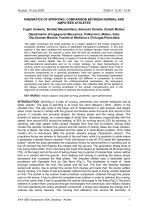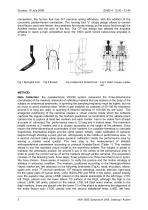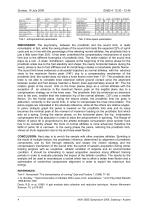 Website:
Roadrunnerfoot Engineering
Website:
Roadrunnerfoot Engineering
Catalog excerpts

KINEMATICS OF SPRINTING: COMPARISON BETWEEN NORMAL AND AMPUTEES ATHLETES Cugini Umberto, Bertetti Massimiliano, Bonacini Daniele, Zanetti Matteo* Dipartimento di Ingegneria Meccanica, Politecnico, Milano, Italia Dip.Scienze Motorie, Facoltà di Medicina e Chirurgia,Pavia,Italia The paper introduces the initial activities of a project related to the kinetic analysis of amputees athletes running by means of dedicated orthopaedic prostheses. In this first session it has been analysed the kinematics of four athletes sample, three normal (the first a high-level pro, the second a junior and the third an amateur) and one unilateral below-knee paralympic amputee. Research objective is to analyse the kinematics of the amputee athlete and the differences in respect of normal athletes. It has to be considered that each normal athlete has its own way of running which depends on his anthropometrical parameters and on its motion strategy: an ideal biomechanics of running, which is a reference to optimise the performance of athlete, doesn't exist. First of all it has been described the running biomechanical phases of normal athletes and the structural components of a sprinting prosthesis; then the system to analyse human movement and finally the adopted protocol for acquisition. The kinematical parameters and the motion strategy adopted by amputee are different in comparison to normal athletes: it has been analysed the anthropometrical parameters, the time-space parameters and pelvis, hip, knee and ankle angles. The collected data will be applied to the design process of running prosthesis in the socket manufacturing and in the alignment of prosthetic components to optimise the performance of the athlete. KEY WORDS: motion capture, amputee running, prosthesis, sport performance. INTRODUCTION: Sprinting is a type of running, performed over shorter distances and at faster speeds. The goal of sprinting is to cover the short distance (100m –200m) in the shortest time. The gait cycle is the basic unit of measurement in gait analysis and begins when a foot comes in contact with the ground and finishes when the same foot returns to the ground. It includes two principal phases: the stance phase and the swing phase. The duration of stance phase, as a percentage of stride time, decreases, proportionally with the speed, from around 60% during the walking, to 30% for running and to 22% for sprinting. In sprinting, with high speed, initial contact changes from hind foot to forefoot. During initial contact the sprinter contacts the ground and the Centre of Gravity takes the lower position, the hip is flexed, the knee is extended and the ankle is in dorsi-flexion position. From initial contact (IC) to mid-stance (MD) the sprinter absorbs energy ("absorption phase"). The propulsive forces are anterior to the joints of hip and knee, while it is posterior to ankle where it generates a plantar flexion moment. From mid-stance to toe-off (TO) starts the "generation phase", where the body generates the propulsive forces for advancement in sprinting and at toe off moment the foot finishes the contact with the ground. The generation phase ends at mid swing frame (MS). From mid-swing the lower limb begins to decelerate till terminal swing (TS). At the begin and at the end of swing phase has to period of double-float, where neither limb is in contact with the ground: from walking and running to sprinting the stance phase decreases and increases the float phase. The amputee athlete uses a dedicated sprint prosthesis with Springlite Foot by Otto Bock (Fig.1). The prosthesis is made of three principal components: the liner, the socket and the foot. The liner, the interface between socket and stump, has to protect the stump from injuries and loads that the stump suffers during running. It is made of soft and elastic material and the level of stump comfort depends on this. The socket is the custom made prosthetic component, obtained through the plaster cast on the stump. It has to allow the complete knee rotation in order to optimize the running, but at the same time it has to guarantee the secure anchorage to the knee.(Fig.2) The foot’s material is carbon fiber, produced through technologies from aeronautic and military industry The foot represents the active prosthetic component: it stores and releases the energy and it reduces the stump traumas. The running foot efficiency has around 80 percents. In XXIV ISBS Symposium 2006, Salzburg – Austri
Open the catalog to page 1
comparison, the human foot has 241 percents spring efficiency, with the addition of the concentric plantar-flexion contraction. The running foot "J" shape design allows to controll dorsi-flexion and knee flexion: the prosthetic foot stores energy as the sound foot through the Achilles tendon and the arch of the foot. The CF foot design has allowed the amputee athletes to reach a high competitive level: the 100m world record below-knee amputee is 11,07s. Fig.4 Helen Hayes marker set METHOD: Data Collection: the optoelectronic VICON system measured the three-dimensional coordinates of the...
Open the catalog to page 2
placed on the calcaneous at the same height above the plantar surface of the foot as the toe marker; the same markers for right arm, hip and leg. The two markers, positioned sideways on the superior iliac spine, are redundant, so that, if during the running, the some markers, could be lost by the athlete, it is possible to reconstruct the model .For landmarks on the prosthesis it has been followed Buckley-method with the amputee on tip-toe: epicondyle on the socket, malleolus, heel, tip of feet and second metatarsal virtual. To analyse the foot behaviour and to verify the right alignment...
Open the catalog to page 3
DISCUSSION: The asymmetry, between the prosthetic and the sound limb, is really remarkable: in fact, while the swing phase of the sound limb lasts the expected 22% of sprint cycle and so in line with the percentage of the referring normal athletes, the prosthetic limb is just a little lower than 20%. It has been underlined the compensatory mechanisms of sound limb due to the different kinematics of prosthetic limb. The ankle rotation of the sound limb plays as a rule . A weak dorsiflexion appears at the beginning of the stance phase for the prosthetic ankle due to the foot elasticity and...
Open the catalog to page 4All Roadrunnerfoot Engineering catalogs and technical brochures
-
Catalogue 2023
188 Pages






